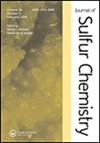利用Biginelli缩合反应合成新型含金刚烷二氢嘧啶
IF 2.1
3区 化学
Q3 CHEMISTRY, MULTIDISCIPLINARY
引用次数: 2
摘要
以β-酮酰胺N-1-金刚烷基乙酰乙酰胺为活性亚甲基化合物的金刚烷、硫脲和芳香醛为原料,通过三组分Biginelli反应合成了含有金刚烷基序的新型二氢嘧啶。通过光谱数据证实了合成的化合物的结构。图形摘要本文章由计算机程序翻译,如有差异,请以英文原文为准。
Synthesis of novel adamantane-containing dihydropyrimidines utilizing Biginelli condensation reaction
Novel dihydropyrimidines incorporating an adamantane motif have been synthesized using a three-component Biginelli reaction of adamantane-containing β-keto amide N-1-adamantyl acetoacetamide as active methylene compound, thiourea, and aromatic aldehydes in more convenient condition and high yields. The structures of the synthesized compounds were confirmed by spectral data.
求助全文
通过发布文献求助,成功后即可免费获取论文全文。
去求助
来源期刊

Journal of Sulfur Chemistry
CHEMISTRY, MULTIDISCIPLINARY-
CiteScore
4.10
自引率
9.10%
发文量
38
审稿时长
6-12 weeks
期刊介绍:
The Journal of Sulfur Chemistry is an international journal for the dissemination of scientific results in the rapidly expanding realm of sulfur chemistry. The journal publishes high quality reviews, full papers and communications in the following areas: organic and inorganic chemistry, industrial chemistry, materials and polymer chemistry, biological chemistry and interdisciplinary studies directly related to sulfur science.
Papers outlining theoretical, physical, mechanistic or synthetic studies pertaining to sulfur chemistry are welcome. Hence the target audience is made up of academic and industrial chemists with peripheral or focused interests in sulfur chemistry. Manuscripts that truly define the aims of the journal include, but are not limited to, those that offer: a) innovative use of sulfur reagents; b) new synthetic approaches to sulfur-containing biomolecules, materials or organic and organometallic compounds; c) theoretical and physical studies that facilitate the understanding of sulfur structure, bonding or reactivity; d) catalytic, selective, synthetically useful or noteworthy transformations of sulfur containing molecules; e) industrial applications of sulfur chemistry; f) unique sulfur atom or molecule involvement in interfacial phenomena; g) descriptions of solid phase or combinatorial methods involving sulfur containing substrates. Submissions pertaining to related atoms such as selenium and tellurium are also welcome. Articles offering routine heterocycle formation through established reactions of sulfur containing substrates are outside the scope of the journal.
 求助内容:
求助内容: 应助结果提醒方式:
应助结果提醒方式:


